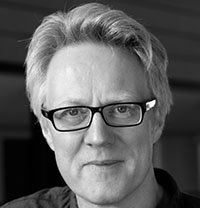By Des Higham
In this issue, Survey and Review readers are invited to “Meet the Flockers.” The article “Heterophilious Dynamics Enhances Consensus,” by Sebastien Motsch and Eitan Tadmor, considers models of flocking and opinion formation as prototypes for self-organized dynamics. The model classes surveyed are nonlinear ODE systems where each “agent” or “particle” in the system is summarized by a vector of state values that may represent geographical location, velocity, or some other time-dependent attribute such as an opinion. The rates of change of each agent’s coordinates are then assumed to be driven by that agent’s relative difference with each other agent; see equation (1.1). The key property of interest in this article is the emergence over long time intervals of a single cluster, or consensus, where all agents tend to a common state, as happens when a jury reaches a unanimous verdict or a collection of birds forms a single flock.
The authors distinguish between models with global and local connectivity, depending upon whether influence is felt between all agents or just those who are sufficiently close in coordinate space, respectively. The techniques of analysis used to establish the results include energy and spectral methods, and they involve concepts from graph theory to handle the time-dependent connectivity structure defined by the interactions. As indicated by the choice of title, the work emphasizes the counterintuitive phenomenon that, in appropriate circumstances, notably with local models, propensity for consensus is enhanced through heterophily—a preference for bonding more closely with far-neighbors than with near-neighbors in coordinate space. In this sense, it is birds of a very different feather that stick together.
As well as surveying and unifying a broad collection of results, the authors provide illustrative computer simulations, concise counterexamples, and open questions. Later sections of the article turn to discrete-time analogues of the continuous-time models, fixed-neighbor interactions, and mean-field, macro-scale limits of the micro-scale particle descriptions. In a final section, the authors give pointers to work in related fields, including cell biology, ecology, transport, economics, marketing, robotics, and sport. Overall, this survey article will bring interested readers up-to-date with a modern, active, and highly applicable subfield of dynamical systems.
Read the paper! (Requires subscription or SIAM membership)
Heterophilious Dynamics Enhances Consensus
SIAM Review, 56(4), 577-621.
 |
Des Higham is a professor in the department of mathematics and statistics at the University of Strathclyde, Glasgow, and serves as section editor for the Survey & Review section of SIAM Review. |